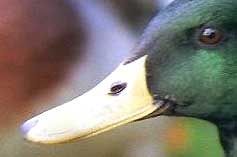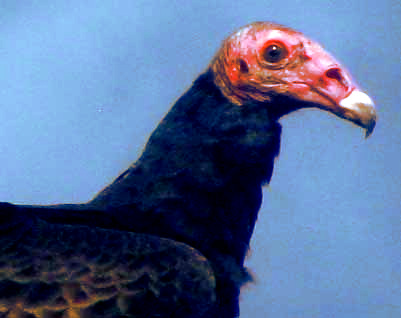SMELLING
 All birds have nasal passages containing the apparatus needed for detecting odors. Nasal passages -- nose holes -- often are easy to see, as on the beak of the male Mallard duck at the right.
All birds have nasal passages containing the apparatus needed for detecting odors. Nasal passages -- nose holes -- often are easy to see, as on the beak of the male Mallard duck at the right.
Some groups of birds have a better developed sense of smell than others, especially certain oceanic birds such as albatrosses and shearwaters, and ground-dwelling ones like New Zealand's Kiwis. To most songbirds in our backyards, however, smelling doesn't appear to be very important, and their ability to smell is thought to be less than that of us humans.

Still, there's the Turkey Vulture, Cathartes aura, a species most North Americans who visit the countryside can spot circling overhead looking for carrion. That's one at the left. Turkey Vultures are famous for their ability to smell carrion from long distances away. Back in the 1930s, a smelly chemical given off by decomposing animals -- ethyl mercaptan -- was added to pipelines carrying natural gas. If a pipeline leaked, the odor of escaping ethyl mercaptan attracted Turkey Vultures, and ground crews could more easily locate the leak.
A freely downloadable technical paper by Simon Potier and others entitled Sight or smell: which senses do scavenging raptors use to find food? provides a good overview of current understanding of the bird ability to smell, especially that of the vultures.
TASTING
In general, among birds the sense of taste is even less needed and therefore less well developed than the sense of smell. The point is made that bird species have up to 500 taste buds, while we humans have 9,000 to 10,000. Birds can taste sweet, sour and bitter, and they can learn how combinations of those tastes can warn them of toxic foods, or invite them to feed.
Many of us have seen a bird gobble up a certain kind of caterpillar bearing no spines or stinging hairs, then spit it out. Surely the caterpillar tasted bad, and it's known that many caterpillar species do taste bad, such as those of the Monarch Butterfly, containing bitter chemicals called cardiac glycosides.
One controlled study on the matter presented ducks a mixture of normal tasting and unpleasant tasting peas. The normal peas were gobbled down but the others were rejected.
Beyond that, it's known that hummingbirds can taste different concentrations of sugar, and sandpipers can taste the presence of worms buried in a mudflat's mud.